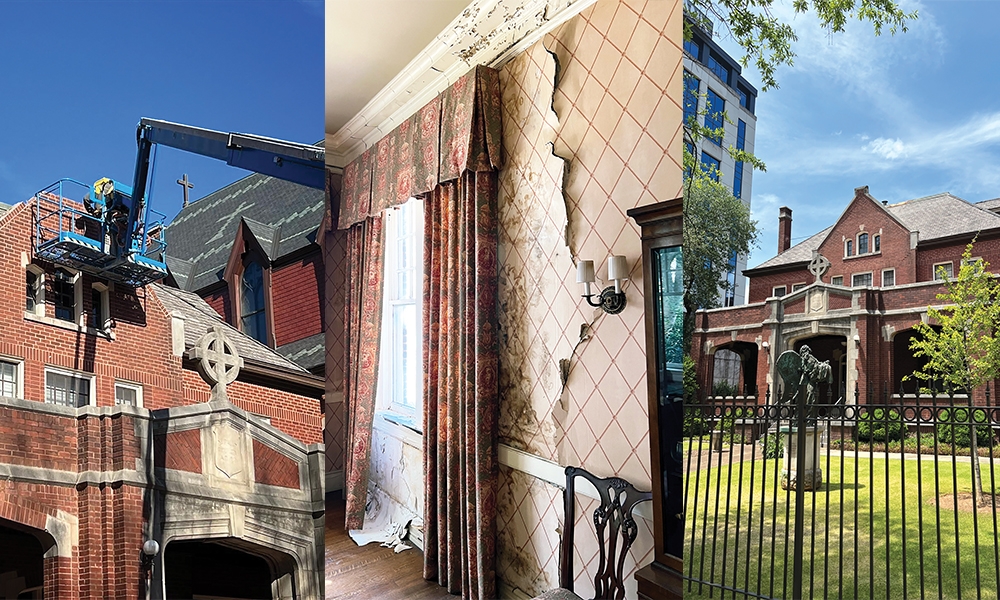
Preserving a piece of history
The Cathedral of St. Paul’s rectory undergoes much needed renovations
The Cathedral of St. Paul’s rectory undergoes much needed renovations
Many in the Diocese of Birmingham have heard the name Father James E. Coyle, and for those who have not, at the time of his murder, he was pastor of the then St. Paul’s Church in Birmingham. The year was 1921, and the priest was embarking on his 25th year of priesthood. To mark the occasion, the parishioners had made plans to raise $25,000 and to present it to Father Coyle for the replacement of the dilapidated, wooden rectory he called home. However, Father Coyle never saw the plan come to fruition. On Aug. 11, Father Coyle presided over the marriage of a Puerto Rican man with a young woman who had converted to Catholicism, all against her father’s will. Shortly after the ceremony, the bride’s father made his way to the steps of St. Paul’s rectory and drew his gun, delivering fatal wounds to the defenseless priest.
Many in the Diocese of Birmingham have heard the name Father James E. Coyle, and for those who have not, at the time of his murder, he was pastor of the then St. Paul’s Church in Birmingham. The year was 1921, and the priest was embarking on his 25th year of priesthood. To mark the occasion, the parishioners had made plans to raise $25,000 and to present it to Father Coyle for the replacement of the dilapidated, wooden rectory he called home. However, Father Coyle never saw the plan come to fruition. On Aug. 11, Father Coyle presided over the marriage of a Puerto Rican man with a young woman who had converted to Catholicism, all against her father’s will. Shortly after the ceremony, the bride’s father made his way to the steps of St. Paul’s rectory and drew his gun, delivering fatal wounds to the defenseless priest.
To honor their beloved, fallen pastor, the parish completed the three-story rectory in 1922. For 101 years, the wood-framed rectory with a masonry “envelope” housed many a priest, yet the “last remaining free-standing, continuously-occupied house in the business district of downtown Birmingham” started to show her age.
Even though changes had been made to the rectory over the years - adding a few bathrooms, retrofitting for HVAC, and modernizing the kitchen - most of the work had been aesthetic in nature.
In recent years, structural failure and the consequent rapid deterioration, both internal and external, became unignorable. On the outside, not only had the faux slate roof failed but the flat, top section of the roof failed, allowing copious amounts of water to seep inside the rectory walls. The foundation had also settled, causing even more water damage to the interior. On the west side of the building, settling became so severe that gaps between the floor and the baseboard measured as much as three-quarters of an inch wide. As if that wasn’t enough, the front façade was at risk of collapsing, limestone decoration had become dislodged, the masonry gutter system failed, the attic was home to bats and squirrels, and the crawl space provided rats and various other vermin access to the interior.
The interior wasn’t much better. Large cracks in walls, blistering of plaster, collapsed ceilings, ungrounded electrical wiring, and peeling wallpaper were only a few items on the list of issues. Original windows, old plumbing, and a completely handicap inaccessible building certainly didn’t help matters either. Most concerning, however, was the growth of black mold throughout.
Knowing something needed to be done to save the building, sooner rather than later, Father Bryan Jerabek, pastor and rector of the Cathedral of St. Paul, consulted with parishioners, community members, the parish Finance Council, Bishop Steven Raica, and the College of Consultors of the diocese. Thus, the “Honoring Father Coyle Capital Campaign” was organized and set into motion. The campaign’s first phase goal was $1.5 million.
Work on the rectory began Nov. 6, 2023, and is currently still in progress with the end scheduled for some time in late summer. When the first phase is complete, helical pier support will have been added, brickwork will have been re-pointed, the roof will have been made water-tight, a handicapped ramp will have been installed, the leaning façade will have been rebuilt with steel support, and major wall cracks in the dining room will have been repaired.
While many needs and wants will remain following the completion of the first phase, the renovations will enable the structure to stand as a lasting witness not only to the history of Catholicism in the Diocese of Birmingham in Alabama but also to the life of a man by the name of Father James E. Coyle who gave his life in service to the Church.
Just as parishioners back in 1922 came together, giving of their treasure to honor Father Coyle’s memory, the parishioners of today are doing the same to preserve it. Support doesn’t stop there, though. Bishop Raica even provided a financial guarantee so that work could begin right away, and the diocesan Office of Development and Stewardship worked to secure grant money. “As with any gift given to the Church, it is given to the Lord, and ‘God loves a cheerful giver,’” says Father Jerabek. To learn more about the Honoring Father Coyle Capital Campaign, please visit stpaulbhm.org/cc/.
